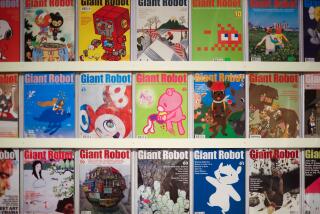BAREFOOT GEN: A CARTOON STORY OF HIROSHIMA by Keiji Nakazawa; translated by Project Gen. Philadelphia (New Society: $29.95, hardcover; $9.95, paperback; 300 pp.)
To bring up Hiroshima in conversation with many Americans is still almost a sure way to get, in return, Pearl Harbor remembered. Since Hiroshima remains a guilt wound in the American psyche, the earlier attack on our Navy is offered again and again in hope of balancing the moral scales.
“Barefoot Gen” makes all that unnecessary. It never once blames America or the American people for what happened in 1945. The only black-hearted villains here are Japanese--militarists and rally-round-the-flag opportunists who progressively drove their own compatriots first into deprivation and then into the intransigence that precipitated the bombings and terrible loss of life. Today many students of that period see Truman’s deployment of “Little Boy” and “FatBoy” as a signal sent more to Moscow than to Tokyo, but “Barefoot Gen” never brings that up. Intended initially only for a Japanese readership, it never projects the blame away from home. And this, interestingly, is what makes this a good book about Hiroshima for Americans who are otherwise allergic to the topic; it tells the story without raising the specter of some special degree of American culpability for what happened.
“Hadashi no Gen,” the original, was something of a sensation in Japan. First serialized by its creator, Keiji Nakazawa, during 1972-73, it quickly found a wide readership. The first treatment of this topic in the cartoon medium, the story of schoolboy Gen easily caught on among young Japanese readers. Adult readers found it compelling as well. In the portion now translated into English, Gen, his younger brother Shinji and their pregnant mother, living and starving in Hiroshima before the bomb even fell, all suffer social ostracism when the father of the household comes to see through the rhetoric of the militarists and dares say so. This candor brings jailings for him and the name of “traitor” down on his sons. The only neighbor willing to befriend rather than jeer at the family is a Korean named Pak. Gen’s father takes the occasion to point out to his sons how racism and militarism link up; deemed no better than dogs, Koreans and Chinese are made into materiel, working the mines like machines. (Often overlooked, incidentally, is the fact that an estimated 23,000 Koreans, many of them forced residents in Japan, were victims of the Hiroshima blast.)
Clearly created with an eye to the future as much as to the past, “Barefoot Gen” dared to say that endurance and self-sacrifice, highly touted virtues among the Japanese, can lead to holocaust just as easily as to glory. Although pushed and directed from above, the Japanese would not have moved all the way to the tragic, horrendous finale of 1945 without the multitude’s willingness to play bit parts, mouth patriotic lines, ostracize dissenters, and move about like sheep most of the time. This portion of the larger Gen saga vividly depicts the co-opting of common people. Overt violence is directed against persons such as Gen’s father who question official dicta. Much more subtle and insidious, however, is the conservative community’s capacity to herd itself. The cartoon frames of street scenes catch it all: the machismo in the TROMP TROMP marching of uniformed young men, the BZZZ BZZZ of aproned housewives, the outflung wing-arms and throaty ZOOOOMS of little boys already imagining themselves to be Zeros or kamikazes. This society, moreover, is encompassed by written slogans (“Luxury is the Enemy”; “The Enemy is Desperate! Prepare for the Mainland Battle!”). Here the high literacy achievement of the Japanese is subverted by mind-mushing, omnipresent slogans that, when recalled now, give an ironic twist to the semiologist Roland Barthe’s characterization of Japan as an “empire of signs.”
For about 30 years after 1945, the Japanese as a people felt compelled to tell the Hiroshima story to the world; its horror remained deeply etched in the national consciousness. Even when foreign tourists, students and businessmen in Japan did not wish to hear such, ordinary Japanese in conversation would bring up the horror of all war but especially the madness of nuclear arms. It was common people, often the same ones co-opted during the war, who would catch the ear of anyone willing to listen or simply unable to escape. Convinced that Hiroshima need not scar Japanese-American relations, such people also insisted that this issue must transcend the politics of left and right.
Over the last decade or so, however, the Japanese memory seems to have slipped a good deal. Certainly this is, in part, because the generation with vivid recollections of the war is passing. But it also appears that today’s Japanese insist that the national business is business, not peace. For a few decades preeminent among the nations for sensitivity on issues of armament and the threat of nuclear war, Japan now seems satisfied to be “Number One” for very different reasons. The moral edge is dulled.
Fourth-fifths of “Barefoot Gen” depicts the deterioration of Hiroshima as a city even before the horror from the skies on Aug. 6, 1945. The national wealth was disappearing into the military’s voracious maw; people on the streets were afraid of one another and given to violence; a good portion of the city’s people was deprived and hungry. In 1987, ironically, it is American cities that increasingly resemble that Hiroshima, whereas Japanese cities--with their efficiency, much fairer distribution of wealth, and remarkable freedom from violence--are a source of envy now. The reasons for the switch-about are complex. “Barefoot Gen” merits careful reading, especially in schools and especially now, on our side of the Pacific Ocean. It is a graphic “lest we forget” depiction of nuclear devastation and a troubling index to certain kinds of urban ruin even before the bombs fall. The final cataclysm is intolerable, but the earlier days of “national effort” are hardly benign.
More to Read
Sign up for our Book Club newsletter
Get the latest news, events and more from the Los Angeles Times Book Club, and help us get L.A. reading and talking.
You may occasionally receive promotional content from the Los Angeles Times.






